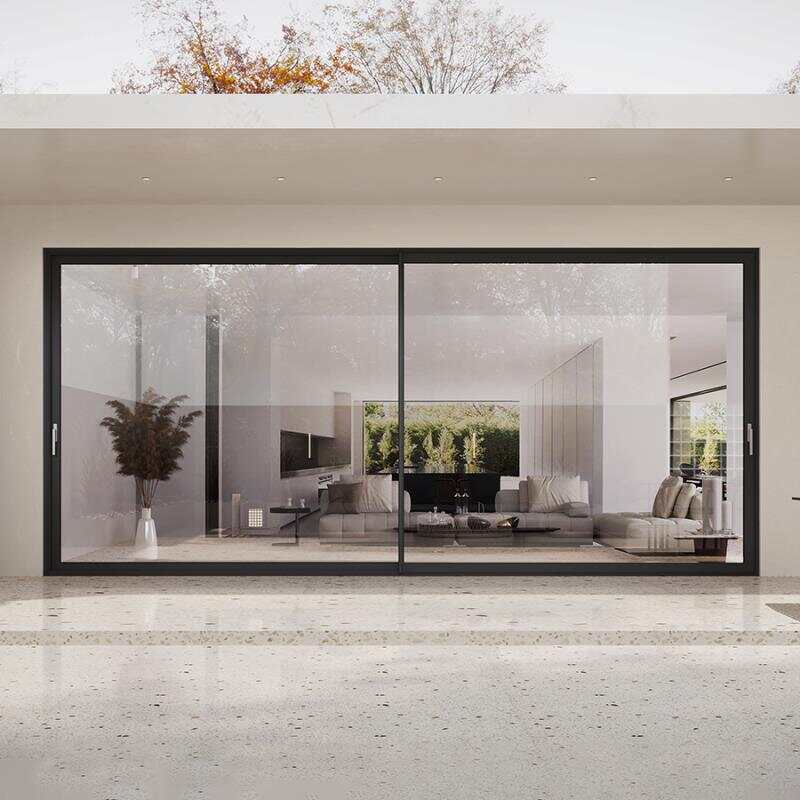Email format error
Email cannot be empty
Email already exists
6-20 characters(letters plus numbers only)
The password is inconsistent
Email format error
Email cannot be empty
Email does not exist
6-20 characters(letters plus numbers only)
The password is inconsistent


The Evolution and Impact of Aluminum Sliding Doors
Aluminum sliding doors have come a long way from their early beginnings, evolving into a modern architectural staple. Their journey reflects advancements in materials, manufacturing technologies, and design philosophies. In this article, we’ll explore the historical evolution of aluminum sliding doors, recent innovations and trends, their role in contemporary architecture, challenges faced in manufacturing, and essential maintenance tips.
1. The Evolution of Aluminum Sliding Doors
1.1 Historical Perspective
Sliding doors have been around for centuries, but their modern incarnation began to take shape in the early 20th century. Originally, sliding doors were made from heavy materials like wood or steel, which often limited their practicality due to weight and maintenance issues. The introduction of aluminum marked a significant shift in design and functionality.
Aluminum’s lightweight nature, coupled with its resistance to rust and corrosion, made it an ideal candidate for sliding doors. This transition began in the mid-20th century when architects and builders started to recognize the advantages of aluminum. The new material allowed for larger glass panes and slimmer frames, which not only improved aesthetics but also enhanced functionality.
1.2 Technological Advancements
Over the decades, the manufacturing process for aluminum sliding doors has evolved significantly. Early methods involved basic extrusion techniques and manual assembly, but advancements in technology have introduced automation and precision engineering.
Modern aluminum door sliding factories now use advanced machinery and automated systems to ensure high-quality production. CNC machines and robotic systems have increased the precision of cuts and joins, resulting in more reliable and aesthetically pleasing doors. Additionally, the introduction of thermal breaks and improved glazing techniques has enhanced the energy efficiency of these doors, making them a more sustainable choice for contemporary architecture.
2. Innovations and Trends in Aluminum Sliding Doors
2.1 Recent Innovations
The aluminum sliding door industry is continually innovating to meet the evolving demands of consumers and architects. One major advancement is the development of new aluminum alloys and coatings that improve durability and aesthetics. For instance, powder coating has become a popular finish due to its ability to provide a wide range of colors and textures while resisting wear and tear.
Manufacturing technologies at aluminum door sliding factories have also seen significant improvements. Enhanced automation and robotic systems have streamlined production, leading to more consistent quality and reduced lead times. Furthermore, the integration of smart technology into sliding doors is a growing trend. Features such as automated opening systems, integrated sensors, and remote control functionalities are becoming standard in high-end models.
2.2 Trends in Architecture
Aluminum sliding doors are influencing contemporary architectural trends in several ways. One notable trend is the emphasis on open, airy spaces that blur the lines between indoor and outdoor environments. The large glass panels of aluminum sliding doors facilitate this seamless transition, allowing natural light to flood interior spaces and providing expansive views of the outdoors.
Sustainability is another significant trend driving the demand for aluminum sliding doors. Modern architectural practices focus on energy efficiency and eco-friendly materials, and aluminum sliding doors fit well within these guidelines. With advancements in thermal insulation and eco-friendly production processes, these doors help reduce energy consumption and environmental impact.
3. The Role of Aluminum Sliding Doors in Modern Architecture
3.1 Architectural Trends
In contemporary architecture, aluminum sliding doors are prized for their ability to enhance both functionality and aesthetics. Their sleek, minimalist design complements modern architectural styles, including industrial, contemporary, and minimalist designs. The ability to create large openings without bulky frames aligns perfectly with the modern desire for clean lines and open spaces.
Aluminum sliding doors also contribute to the functionality of modern buildings. They provide an efficient way to divide spaces while maintaining an open feel, making them ideal for both residential and commercial applications. Whether used to separate living areas or to provide access to outdoor spaces, these doors offer a practical solution that doesn’t sacrifice style.
3.2 Famous Projects
Several high-profile architectural projects have prominently featured aluminum sliding doors, showcasing their versatility and impact. For example, the iconic Apple Park campus in Cupertino, California, utilizes aluminum sliding doors to create a seamless connection between its interior and the surrounding landscape. Similarly, the High Line in New York City, an elevated park built on a former rail line, employs aluminum sliding doors in its design to enhance the flow of light and air throughout the space.
These projects highlight how aluminum sliding doors can be used to achieve both functional and aesthetic goals in architecture. Their ability to integrate with diverse design elements and environments makes them a popular choice for architects working on ambitious and innovative projects.
4. Challenges and Solutions in Aluminum Door Manufacturing
4.1 Common Issues
Despite their many benefits, the manufacturing of aluminum sliding doors is not without challenges. One common issue is supply chain disruptions, which can impact the availability of materials and extend production timelines. These disruptions can be caused by various factors, including global trade issues and fluctuations in raw material prices.
Quality control is another challenge faced by aluminum door sliding factories. Ensuring that each door meets high standards of performance and durability requires rigorous testing and inspection processes. Variability in manufacturing can lead to issues such as misalignment, poor sealing, and inconsistent finishes.
Technological hurdles also present challenges. As manufacturers strive to incorporate new technologies and features, they must balance innovation with practical constraints such as cost and production capabilities. Implementing advanced technologies can be complex and may require significant investment.
4.2 Innovative Solutions
To address these challenges, the aluminum door sliding industry has embraced several innovative solutions. For supply chain issues, manufacturers are working on diversifying their sources of materials and improving inventory management practices. By developing closer relationships with suppliers and exploring alternative materials, they can mitigate the impact of disruptions.
In terms of quality control, modern factories are adopting advanced testing and inspection technologies. Automated systems and real-time monitoring tools help identify defects and ensure consistent quality throughout production. Additionally, manufacturers are investing in training and development to enhance the skills of their workforce and improve overall production standards.
Technological advancements are also playing a crucial role in overcoming manufacturing challenges. New production techniques, such as 3D printing and advanced robotics, are being explored to streamline processes and reduce costs. These innovations help manufacturers stay competitive while meeting the evolving demands of the market.
5. Maintenance and Care for Aluminum Sliding Doors
5.1 Upkeep Tips
Proper maintenance is essential to ensure the longevity and performance of aluminum sliding doors. Regular cleaning is important to prevent the buildup of dirt and grime, which can affect the appearance and functionality of the doors. Using a mild detergent and a soft cloth or sponge is usually sufficient for cleaning the aluminum frames and glass panes.
Maintaining the sliding mechanisms is also crucial. Regularly inspecting and lubricating the tracks and rollers can help prevent issues such as sticking or uneven movement. Additionally, checking the seals and weatherstripping for signs of wear can help maintain energy efficiency and prevent drafts.
Preventative measures, such as addressing small issues before they become major problems, can significantly extend the lifespan of aluminum sliding doors. For example, ensuring that the doors are properly aligned and adjusted can prevent strain on the mechanisms and reduce the likelihood of misalignment.
5.2 Troubleshooting Common Issues
Despite regular maintenance, some common issues may still arise with aluminum sliding doors. One common problem is sticking or difficult movement, which can often be attributed to debris in the tracks or worn-out rollers. Cleaning the tracks and lubricating the rollers can usually resolve this issue.
Misalignment is another issue that can affect the performance of sliding doors. If the doors do not close properly or are difficult to open, it may be necessary to adjust the hinges or tracks. In some cases, professional help may be required to ensure proper alignment and functionality.
Leaks and drafts can also be problematic, particularly in regions with extreme weather conditions. Inspecting and replacing seals and weatherstripping can help address these issues and improve the energy efficiency of the doors.
Conclusion
The evolution of aluminum sliding doors reflects broader trends in design, technology, and manufacturing. From their historical roots to their current status as a modern architectural staple, aluminum sliding doors have undergone significant advancements. Innovations in materials and manufacturing processes, along with their impact on contemporary architecture, underscore their importance in today’s design landscape.
As the industry continues to tackle challenges and embrace new technologies, aluminum sliding doors will remain a key element in creating functional and aesthetically pleasing spaces. By understanding their history, current trends, and maintenance needs, homeowners and architects can make informed decisions about incorporating these versatile doors into their projects.

